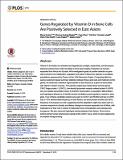Por favor, use este identificador para citar o enlazar a este item:
http://hdl.handle.net/10261/151593COMPARTIR / EXPORTAR:
 SHARE SHARE
 CORE
BASE CORE
BASE
|
|
| Visualizar otros formatos: MARC | Dublin Core | RDF | ORE | MODS | METS | DIDL | DATACITE | |

| Título: | Genes Regulated by Vitamin D in Bone Cells Are Positively Selected in East Asians |
Autor: | Arciero, Elena; Biagini, Simone Andrea CSIC ORCID; Chen, Yuang; Xue, Yali; Luiselli, Donata; Tyler-Smith, Chris; Pagani, Luca; Ayub, Qasim | Fecha de publicación: | 31-dic-2015 | Editor: | Public Library of Science | Citación: | PLoS ONE 10(12): e0146072 (2015) | Resumen: | Vitamin D and folate are activated and degraded by sunlight, respectively, and the physiological processes they control are likely to have been targets of selection as humans expanded from Africa into Eurasia. We investigated signals of positive selection in gene sets involved in the metabolism, regulation and action of these two vitamins in worldwide populations sequenced by Phase I of the 1000 Genomes Project. Comparing allele frequency-spectrum-based summary statistics between these gene sets and matched control genes, we observed a selection signal specific to East Asians for a gene set associated with vitamin D action in bones. The selection signal was mainly driven by three genes CXXC finger protein 1 (CXXC1), low density lipoprotein receptor-related protein 5 (LRP5) and runt-related transcription factor 2 (RUNX2). Examination of population differentiation and haplotypes allowed us to identify several candidate causal regulatory variants in each gene. Four of these candidate variants (one each in CXXC1 and RUNX2 and two in LRP5) had a >70% derived allele frequency in East Asians, but were present at lower (20–60%) frequency in Europeans as well, suggesting that the adaptation might have been part of a common response to climatic and dietary changes as humans expanded out of Africa, with implications for their role in vitamin D-dependent bone mineralization and osteoporosis insurgence. We also observed haplotype sharing between East Asians, Finns and an extinct archaic human (Denisovan) sample at the CXXC1 locus, which is best explained by incomplete lineage sorting. | Versión del editor: | https://doi.org/10.1371/journal.pone.0146072 | URI: | http://hdl.handle.net/10261/151593 | DOI: | 10.1371/journal.pone.0146072 | ISSN: | 1932-6203 |
| Aparece en las colecciones: | (IBE) Artículos |
Ficheros en este ítem:
| Fichero | Descripción | Tamaño | Formato | |
|---|---|---|---|---|
| journal.pone.0146072.PDF | 3,2 MB | Adobe PDF |  Visualizar/Abrir |
CORE Recommender
PubMed Central
Citations
3
checked on 06-abr-2024
SCOPUSTM
Citations
5
checked on 15-abr-2024
WEB OF SCIENCETM
Citations
4
checked on 27-feb-2024
Page view(s)
284
checked on 18-abr-2024
Download(s)
204
checked on 18-abr-2024

